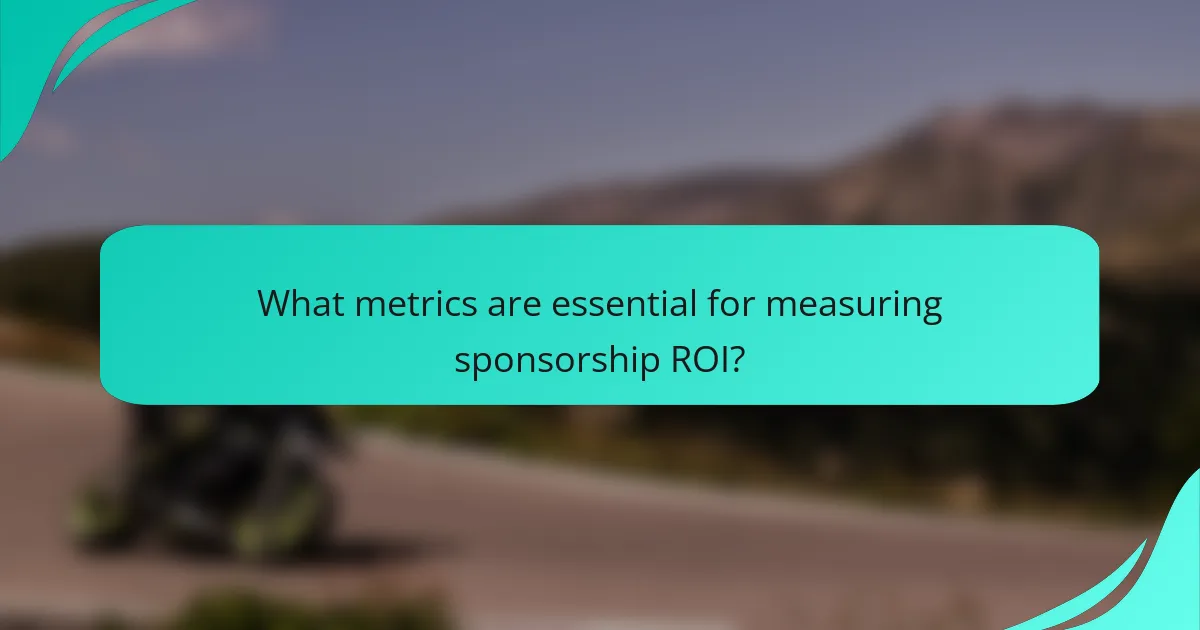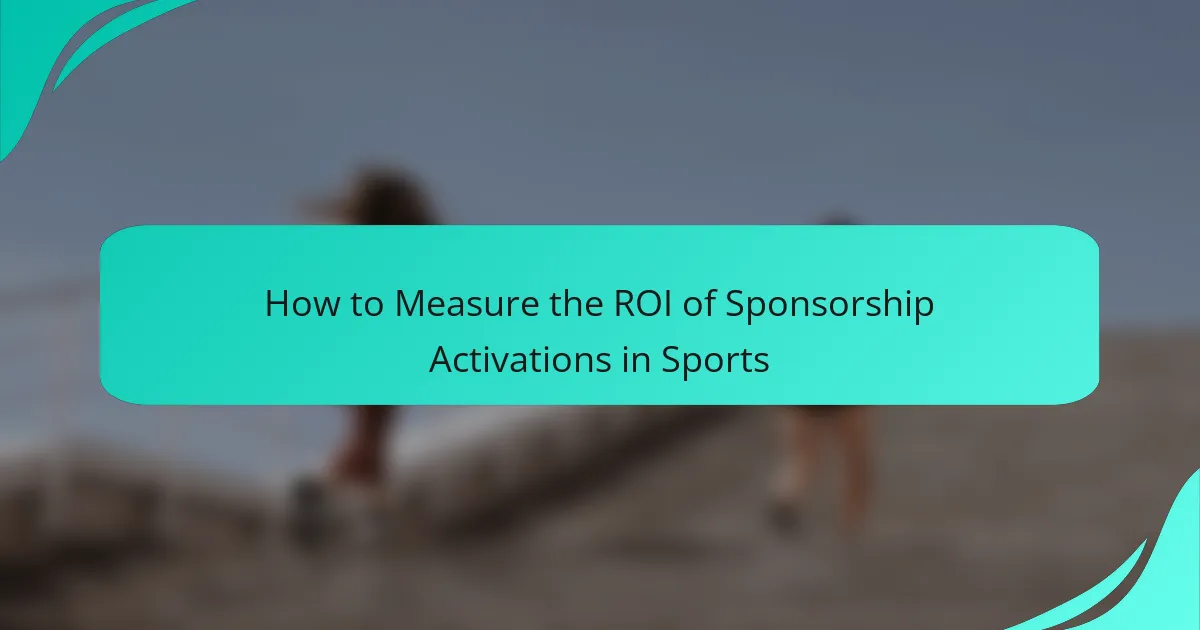Measuring the ROI of sponsorship activations in sports is crucial for understanding the effectiveness of your investment. By focusing on key performance metrics such as media value equivalency, audience engagement, and sales conversions, you can quantify the benefits gained against the costs incurred. This comprehensive analysis not only highlights the financial impact but also informs future sponsorship strategies.

How can you effectively measure ROI for sports sponsorships?
To effectively measure ROI for sports sponsorships, focus on quantifying the benefits gained from the investment compared to the costs incurred. This involves analyzing various performance metrics, brand exposure, audience engagement, sales conversions, and gathering feedback from stakeholders.
Utilize performance metrics
Performance metrics provide a quantitative basis for assessing the effectiveness of sponsorship activations. Key metrics include impressions, reach, and frequency, which help gauge how many people were exposed to the sponsorship. Tracking these metrics over time can reveal trends and inform future sponsorship decisions.
Consider using tools like Google Analytics or social media insights to collect data. Establish benchmarks based on previous activations to compare performance and identify areas for improvement.
Analyze brand exposure
Brand exposure measures how often and in what context your brand is seen during sports events. This can include logo visibility on signage, merchandise, and digital platforms. Understanding the extent of brand exposure helps determine its impact on brand awareness and perception.
Utilize tools like media monitoring services to track mentions and visibility across various channels. Comparing brand exposure against competitors can also provide valuable insights into market positioning.
Evaluate audience engagement
Audience engagement assesses how well the sponsorship resonates with fans. This can be measured through social media interactions, event attendance, and participation in promotional activities. High engagement levels often correlate with positive brand sentiment and loyalty.
Implement strategies such as interactive campaigns or contests to boost engagement. Monitor engagement metrics regularly to adapt your approach and enhance the effectiveness of future activations.
Track sales conversions
Tracking sales conversions directly links sponsorship activities to revenue generation. This involves analyzing sales data before, during, and after sponsorship events to identify any increases in sales attributable to the sponsorship. Look for patterns in customer behavior that align with sponsorship timing.
Utilize promo codes or special offers tied to sponsorships to better track conversions. This allows for a clearer understanding of how sponsorships influence purchasing decisions.
Implement surveys and feedback
Surveys and feedback from fans and customers provide qualitative insights into the effectiveness of sponsorship activations. Gathering opinions on brand perception and event experiences can highlight strengths and areas for improvement. Consider conducting surveys immediately after events for timely feedback.
Utilize online survey tools to streamline data collection. Analyzing this feedback alongside quantitative metrics creates a comprehensive view of sponsorship effectiveness, guiding future strategies.

What metrics are essential for measuring sponsorship ROI?
To effectively measure the ROI of sponsorship activations in sports, focus on key metrics that reflect both direct and indirect benefits. Essential metrics include media value equivalency, social media reach and impressions, website traffic increase, and customer acquisition cost.
Media value equivalency
Media value equivalency (MVE) quantifies the value of media exposure gained through sponsorships. It estimates how much it would cost to purchase the same amount of advertising space or time, providing a clear financial perspective on the sponsorship’s impact.
To calculate MVE, consider factors like the reach of the event, the duration of exposure, and the type of media coverage received. For instance, if a sponsorship results in significant television coverage, the MVE can be substantial, often reaching tens of thousands to millions of dollars depending on the event’s profile.
Social media reach and impressions
Social media reach and impressions measure how many people see and interact with content related to the sponsorship. High reach indicates a broad audience, while impressions reflect the total number of times content is displayed, regardless of engagement.
Track metrics such as likes, shares, comments, and overall engagement rates across platforms like Facebook, Instagram, and Twitter. A successful campaign might achieve millions of impressions, translating to increased brand visibility and potential customer interest.
Website traffic increase
Monitoring website traffic increase helps assess how sponsorships drive visitors to your site. A spike in traffic following a sponsorship activation suggests effective audience engagement and interest in your brand.
Utilize analytics tools to compare baseline traffic before and after the sponsorship event. Look for increases in unique visitors, page views, and session duration. A well-executed sponsorship might lead to traffic growth of 20-50% or more, depending on the event’s popularity.
Customer acquisition cost
Customer acquisition cost (CAC) evaluates the total cost of acquiring a new customer through sponsorship activities. This metric is crucial for understanding the financial efficiency of your marketing efforts.
To calculate CAC, divide the total marketing expenses related to the sponsorship by the number of new customers gained during that period. Aim for a CAC that aligns with your overall marketing budget; a lower CAC indicates a more effective sponsorship strategy. For example, a CAC of under $100 is often considered favorable in many industries.

How do you calculate the financial impact of sponsorship?
Calculating the financial impact of sponsorship involves assessing various metrics that reflect the value generated from the investment. Key factors include revenue generated, cost per impression, and return on ad spend (ROAS), which together provide a comprehensive view of sponsorship effectiveness.
Revenue generated from sponsorship
Revenue generated from sponsorship is the total income directly attributable to the sponsorship activities. This can include ticket sales, merchandise sales, and any increased sales attributed to brand exposure during the event.
To effectively measure this, track sales data before, during, and after the sponsorship period. Comparing these figures can help isolate the impact of the sponsorship on overall revenue.
Cost per impression analysis
Cost per impression (CPI) analysis evaluates the cost-effectiveness of the sponsorship by calculating how much is spent for each impression made on the audience. This metric helps determine if the sponsorship is delivering value relative to its cost.
To calculate CPI, divide the total sponsorship cost by the estimated number of impressions generated. For example, if a sponsorship costs $100,000 and generates 1 million impressions, the CPI would be $0.10 per impression.
Return on ad spend (ROAS)
Return on ad spend (ROAS) measures the revenue generated for every dollar spent on sponsorship. A higher ROAS indicates a more effective sponsorship investment. This metric is crucial for assessing the overall financial impact of the sponsorship.
To calculate ROAS, divide the total revenue generated from the sponsorship by the total cost of the sponsorship. For instance, if a sponsorship costs $50,000 and generates $200,000 in revenue, the ROAS would be 4:1, meaning $4 earned for every $1 spent.

What tools can assist in measuring sponsorship effectiveness?
Several tools can effectively measure sponsorship effectiveness by tracking various metrics such as engagement, traffic, and sales. Utilizing a combination of analytics platforms can provide a comprehensive view of how sponsorships impact overall performance.
Google Analytics for traffic tracking
Google Analytics is a powerful tool for measuring website traffic generated by sponsorship activations. By setting up specific tracking parameters, you can identify how many visitors come from sponsored events or campaigns, allowing you to assess the direct impact of your sponsorships.
To maximize its effectiveness, create custom reports that focus on traffic sources and user behavior related to sponsorships. Look for metrics such as bounce rates, session duration, and conversion rates to gauge engagement levels. Regularly reviewing these metrics can help refine future sponsorship strategies.
Social media analytics platforms
Social media analytics platforms, such as Hootsuite or Sprout Social, provide insights into engagement and reach from sponsorship activations. These tools can track metrics like likes, shares, comments, and overall impressions, helping you understand how well your sponsorship resonates with the audience.
When using these platforms, focus on engagement rates and follower growth during and after sponsorship events. Comparing these metrics to baseline data can reveal the effectiveness of your sponsorship in enhancing brand visibility and audience interaction.
CRM software for sales tracking
CRM software, like Salesforce or HubSpot, is essential for tracking sales generated from sponsorship activations. By linking sponsorship campaigns to specific sales data, you can measure the return on investment (ROI) more accurately.
To leverage CRM effectively, ensure that all sales leads from sponsorship events are tagged appropriately. Analyze the conversion rates of these leads to assess the financial impact of your sponsorships. Regularly updating your CRM with new data will provide a clearer picture of long-term benefits and trends related to sponsorship effectiveness.

What are the best practices for reporting sponsorship ROI?
Reporting sponsorship ROI effectively requires clarity, context, and a focus on measurable outcomes. Best practices include using visual aids, comparative metrics, and emphasizing key performance indicators to provide a comprehensive view of the sponsorship’s impact.
Use clear visualizations
Visualizations such as charts and graphs can make complex data more accessible and understandable. Use bar graphs to compare pre- and post-activation metrics, or pie charts to illustrate budget allocations versus returns. Aim for simplicity to ensure that stakeholders can quickly grasp the key insights.
Consider tools like Tableau or Google Data Studio for creating interactive dashboards. These platforms allow for real-time updates and can help in presenting data in a visually compelling manner, enhancing engagement and comprehension.
Include comparative analysis
Comparative analysis involves evaluating sponsorship performance against previous activations or industry benchmarks. This approach helps to contextualize the ROI, showing whether the current activation met, exceeded, or fell short of expectations.
For instance, if a sponsorship generated a 20% increase in brand awareness compared to a previous activation that achieved 15%, this comparison highlights effectiveness. Include competitor data if available, as it can provide additional context for performance evaluation.
Highlight key performance indicators
Key performance indicators (KPIs) are essential for measuring the success of sponsorship activations. Common KPIs include brand awareness, engagement rates, and sales growth directly attributed to the sponsorship. Clearly define these metrics before the activation to ensure alignment on goals.
For example, if the goal is to increase social media engagement, track metrics like likes, shares, and comments before and after the activation. This focused approach allows for a more straightforward assessment of ROI and helps in making data-driven decisions for future sponsorships.
